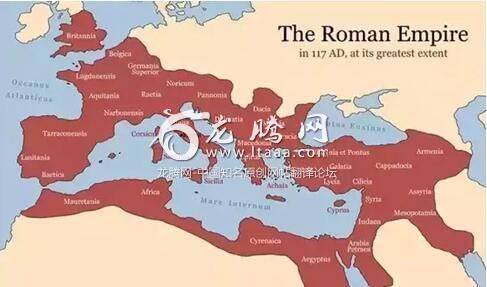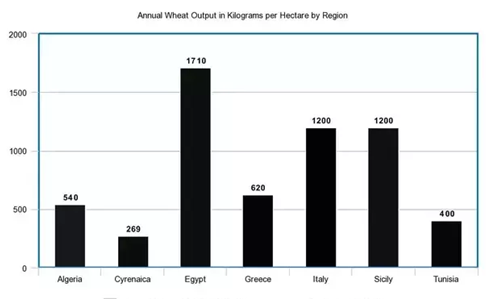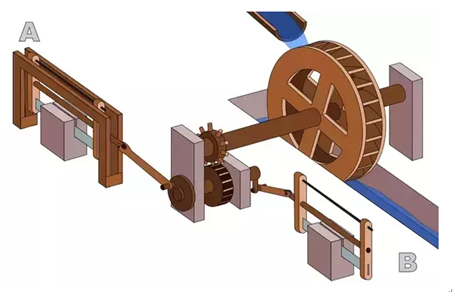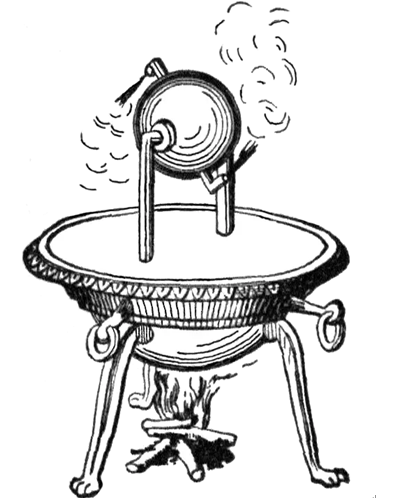罗马与汉朝,谁的技术更加先进? [美国媒体]
quora网友:罗马的钱币制品比其竞争对手汉朝优越得多。一个学术评估显示:直到公元3世纪中叶,罗马每年大概生产了9800万枚钱币。这个数量比汉朝多得多,汉朝在其巅峰时期公元前118年到公元5年,也只不过每年生产平均生产了2.2亿枚钱币,大致只比罗马高出2.24倍。然而,两个文明的不同之处在于:他们在货币的组成......
Whichwas more technologically advanced, the Roman Empire or Han China?
罗马与汉朝,谁的技术更加先进?
论坛地址:Hoang Nghiem (严黄), Si Vis Pacem, Para Bellum
Updated Jan 25 · Featured on Quora'sTwitter
Thanks for the A2A Mike Jen, the short answer is that when viewedobjectively from afar, the Roman Empire (27 BC-1453 AD) along with its Easterncounterpart, the Han Dynasty of China (206 BC-220 AD) were roughly equal, withregards to their respective technological levels of attainment.
The Roman Empire at its heights in 117 AD, with a land area of 5million km^2:
谢邀,简而言之,客观长远的比较,从他们各自的科学水平上看,罗马帝国(27B-1453AD)与其东方版本-中国汉朝(206BC-220AD)大致相当。
罗马帝国在公元117年达到顶峰,幅员大约是500万平方公里:
Honestly speaking though, how is it possible to truly evenanswer this question? What defines “more” technologically advanced anyway? Thenumber of inventions? Probably not. Then there is the matter of potential:could the runner up society have defeated the current technological hegemon,should it have been convenient for them to? Perhaps. “Necessity is the motherof invention” after all according to the Ancient Greek Philosopher, Plato.Then there is the matter of accuracy with regards to bias. Isthere a tendency to exaggerate a particular number in order to fulfil a hiddenagenda? After all, when comparing two great fathers of civilization together,things inevitably tend to get a little… heated let’s just say, at least frompersonal experience. It is a matter of cultural, civilizational and perhapseven national pride after all - completely understandable.
Territories of the Han Dynasty at its heights in 100 AD, with aland area of 6.5 million km^2:
不过老实说,要准确的回答这个问题是不太可能的?到底如何去定义“科技更先进”?发明的数量么?可能不行吧。那么问题来了:亚军是否能击败当前的霸主呢?他们是否有捷径?也许吧。古希腊哲学家柏拉图曾经曰过:“必要性是发明之母”
那么关于偏差的准确性就显得十分重要了。为了满足潜在的目的,是否有夸大某个特定数字的倾向?毕竟当我们比较两个伟大的文明祖师爷之时,讨论必将变得有些白热化,至少以我个人的经验,这关系到文化、文明、甚至会关系到民族自豪感,不过这些都能理解。
汉朝的版图巅峰是在公元100年,大约是650万平方公里:
Which is not to say that this author will be biased, evendespite the fact that he is of a Han Chinese ancestral composition, for heconsiders personal prejudices (of which he has many) to be a blatant insultagainst “good” history writing. So rest assured, he will certainly try (thekeyword here being “try”) to keep it impartial throughout the course of the entireanalysis.
Now, the way this works is simple, the authorwill attempt to compare both Chinese and Roman endeavors together, throughout avariety of different technological areas. He will however, leave it primarilyup to you; his audience to objectively decide based on the presented factsbelow, as to who was truly more advanced between the two civilizations in aparticular area.
这并不代表笔者带有偏见啊,虽然笔者的祖先是汉朝人,但不代表他会带有个人偏见(虽然笔者有很多)
那么好了,规则很简单,笔者将努力尝试透过不同技术领域将中国和罗马作一番比较。接着笔者会将答案留给你们自己来决定;至于两个文明在哪个特定领域更为先进,作为看官们,你们可以基于以下的贴出的事实客观地做出自己的决定,
But of course to keep things fair, as he does not completelytrust in his audience to do so, will also offer up his own verdicts on who wasprobably technologically “superior” with regards to the aforementioned matters,at the end of each comparison. Speaking of which, here are the areas oftechnology which shall be compared throughout the following analysis (some ofwhich do overlap it should be noted):
· Metallurgy
· Agriculture
· Hydraulics and Mechanics
· Medicine
· Astronomy
· Naval Technology
· Aeronautics
· Materials Engineering
· Mathematics
· Civil and Structural Engineering
· Military Technology
With all that said and out of the way however, it’s time to finally beginthe comparison.
Warning:Long answer dead ahead of 18,900 words.
当然了,为了保证公平,由于笔者不完全信任他的观众,关于之前所述的问题,哪一方可能在科技上更为优越,在各项比较完成之后,笔者也将提出自己的个人判断。说到这里,以下是分析中应进行比较的技术领域(需要注意的是有些部分可能会有重叠)
· 冶金
· 农业
· 水利与机械
· 医药
· 天文
· 海军科技
· 航空学
· 材料工程
· 数学
· 土木与结构工程
· 军事科技
说了这么多,现在是时候开始比较了。
温馨提示:答案很长,长达18900字。
Metallurgy
Roman Metallurgy was known to be unbelievably advanced for its time. Atthe peak of its production around 150 AD, Roman Silver production had alreadybeen estimated to have been 5–10 times larger than both “Dark Ages” Europe, andthe mighty Abbasid Caliphate (750–1258 AD)’s Silver production combined at thedawn of the 9th Century AD.
Roman productions also of both Copper and Bronze meanwhile, remainedunsurpassed anywhere in the world until the Industrial Revolution of the mid19th Century. Lead on the other hand, was produced on a scale so large, thatsome Historians have even gone so far as to claim that its production led to,“the oldest large-scale hemispheric pollution ever reported” in the History ofMan.
Case in point, based on the projections of many different sources alike,here is a table below comparing the Han Chinese, and Roman Metal Productions inmetric tonnes; (Source: Comparison between Roman and Han Empires):
冶金
罗马的冶金技术,在那个年代看来可谓是先进到令人难以置信的。公元150年达到产量巅峰,在公元9世纪初期,罗马的白银产量据估计要比欧洲“黑暗时代”与“哈里发王国”时期的产量总和高出5-10倍。
与此同时,罗马也生产铜与青铜,直到19世界中期,其产量一直冠绝全球。另一方面,罗马的铅产量规模也十分巨大,以至于有些历史学家甚至宣称:罗马的铅生产导致了人类历史上“有史以来报告的最古老的大规模铅污染”。
例如,基于许多不同类似史料的估计,以下列了一张汉朝与罗马金属制品产量,单位是公吨:

In saying that on the other hand, Roman production of coins was farsurpassed by its Han counterparts.
By the mid 3nd Century AD, the Romans had managed to produce roughly 98million coins annually by one academic estimate. This greatly contrasted withthe Han Chinese, who at its peak from 118 BC to 5 AD, managed to produce onaverage a magnitude of 220 million coins per year, or roughly 2.24 times morethan the Romans did.
The difference however between the two civilizations; was the compositionof which their currencies were made of. Han coins for one, were either made outof Copper, or Bronze Alloy (Copper mixed with Tin). Roman coins on the otherhand often varied between not just Copper, but Bronze, Silver and Gold alike.This suggests that Han production of Copper, whilst presently unknown at anofficial level, would most likely have outclassed their Roman counterparts by asignificant margin.
The different types of coins which existed under the RomanEmpire:
而另一方面,罗马的钱币制品产量,却被其竞争对手汉朝大幅超越。
一个学术评估显示:直到公元3世纪中叶,罗马每年大概生产了9800万枚钱币。与罗马形成鲜明对比的是,汉朝在其巅峰时期公元前118年到公元5年,每年平均生产了2.2亿枚钱币,大概比罗马高出2.24倍 。然而,两个文明的不同之处在于:他们在货币的组成部分上是有所不同的,汉朝的钱币由铜或青铜合金(铜与锡的合金)制成。然而罗马的钱币花样就多了,不光有铜,也有青铜的、银的以及黄金的。这说明,汉朝的铜产量,虽然目前没有官方数据,但很可能已经大幅落后于其竞争对手罗马。
罗马帝国时代存在的不同钱币类型:
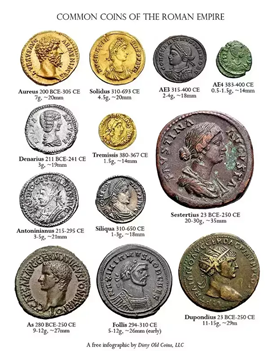
A Chinese “Wuzhu” coin dating back to the Era of the “MartialEmperor”, Han Wudi (reigned 141–87 BC):
汉朝汉武帝时代(公元前141-公元前87年在位),中国的五铢钱:

The Roman Empire at this point in time, had also just independentlyinnovated the concept of “Cast Iron Tools”. Archaeological evidence howevermaintains, that this was done quite late in their history during the ImperialEra; sometime within the 4th-5th Centuries AD.
The Han meanwhile did not invent cast iron tools themselves, but had hadit by that point in time for roughly 500 years already; an entire 1,000 yearsbefore the Romans did, and therefore presumably outclassed the latter in castiron based objects, with regards to not only quantity, but even quality aswell.
This is an understatement really, since Cast Iron production was actuallyperfected during the 426 year long reign of the Han Dynasty, through the use ofspecialist furnaces which converted Iron ore into “Pig Iron”, and from thereinto “Cast Iron”, greatly improving civil and military tools alike.
Evidence meanwhile, for large scale mining operations and processingestablishments, have to this day been discovered en masse throughout the formerterritories of Roman Iberia.
Roman ingots of lead from the mines of Cartagena, Spain:
罗马帝国在彼时,也是刚刚独立发明了“铸铁工具”的概念。然而考古证据显示,这是在罗马帝国较晚时期才完成的发明;大约在公元4-5世纪之间的某个时期。
与此同时,汉朝并没有自己发明铁制工具,但是已经使用铁制品有大约500年了,比罗马早了整整1000年,所以想必在铁器方面是超越了后者的,不仅从数量上,在质量上也是如此。
而这其实只是一个保守的描述而已,因为在汉朝426年的统治岁月中,铁器是很完美的。通过专用的炼炉将铁矿石转化为“生铁”,这大幅改善了民用及军用器具的品质。
与此同时,有证据显示,在罗马伊比利亚故地,发现了大量的大规模采矿与加工场所。
在西班牙卡塔赫纳矿山发现的铅锭:

It was a similar case also for the former domains of Britannia inaddition, which was likewise overflowing with natural wealth at the time. Goldfor example has been discovered to have been mined at Dolaucothi in Wales,Copper and Tin in Cornwall, and Lead in Pennines and the Mendip Hills.Britannia’s Iron Production alone in fact, was 2,250 tonnes annually, oralready 50% of Han China’s total Iron production at a national level.
Italian steel meanwhile, limited as it was due to the fact that Romanfurnaces had a limit of roughly 1300°C, roughly 240°C short of the ability tomelt “pure” iron, still to this day is widely considered by Historians all overthe world alike, to have remained unrivalled at its peak. Indeed, even in theface of the aforementioned limitations, they were still able to forge “WroughtIron”, from which a form of steel known as “Wootz” was derived.
Verdict: The Roman Empire would appear to have been more advanced with regards to Metallurgy. The quantity of Roman produced metals, unrivalled until the advent of the Industrial Revolution nearly 1,850 years later gives them a decisive edge over the Han, despite the fact that the Chinese had some notable advantages also. Rome: 1; Han: 0.
此外,在大不列颠故地也发现了类似的情况,彼时该地区充满了自然资源。比如在威尔士的多莱克西就发现了金矿,在康沃尔地区发现了铜矿和锡矿,在奔宁山脉和门迪普山则发现了铅。事实上,不列颠地区的铁年产量达到了2250吨,以国家级别来看,已经达到了汉朝50%的铁制品总产量。
与此同时,意大利的钢铁生产有其局限性,因为罗马熔炉的极限温度大约是1300℃,要融化“纯”铁还差240℃。至今,全球史学界广泛认为其在顶峰时期拥有无与伦比的地位,即便在上述的限制下(指温度不够),他们仍然能通过一种名叫“乌兹钢”的衍生物锻造出熟铁。
结论:在冶金技术方面,罗马帝国似乎更先进一些。罗马的金属制品产量是无与伦比的,直到1850年后工业革命才被超越,相对于汉朝,这是一项决定性优势,虽然汉朝也有一些显着的优势。这一轮,罗马与汉朝,比分为1:0.
Agriculture
The dominance of Roman over Han Agriculture however, is not as clear aswas the case previously for Metallurgy.
Roman Agriculture which of course peaked during the course of the Nerva-AntonineDynasty (96–180 AD), greatly varied by region. But based on sources which havebeen ascertained from Wikipedia via Roman agriculture, state that for every average sowing of135 kg of seed per hectare, the following numbers are returned asalphabetically ordered by province (chart is self-created so no sourceavailable):
农业:
然而,罗马的农业技术相对汉朝,其优势地位就不像前述冶金技术那样明显了。
罗马的农业的巅峰时期是在安敦宁王朝时期(公元90-180年),地区差异非常之大。但是可以基于维基百科已经确定史料来看,维基百科显示:平均每公顷播种135千克,以下数字按省份首字母排列(图表是自创的,所以没有可用资料)
Self-evidently, the annual output of wheat varied by region,which when averaged, returns a number amounting to 848 kg/ha, for the entireRoman Empire, which is surprisingly comparable to levels finally attained bythe countries of a “Least Developed” status in 1963, which today still accountsfor roughly 25% of all nations in the world as of 2018.
From Egypt alone in fact - the most agriculturally productiveregion in the Roman Empire - 20 million modii (or approximately 174.6 millionkg) of wheat were produced, allowing for at least 2/3 of the city of Rome tohave been fed alone, or 670,000 individuals roughly. If this number is constantfor the population as a whole, then based on the derived calculationsresultant, would amount to an annual national production figure of 15.714billion kg of grain per year, or 225 kg of wheat per person.
The Roman Empire was also quite fortunate to have been able topartly “mechanize” their Agricultural productions most notably in addition. Tothis extent, the Romans used a form of automatic harvester, primarily Oxenpowered, allowing them to have harvested ears of wheat as much as required,whilst also simultaneously rejecting its body at a parallel level.
The aforementioned Gallo-Roman Harvesting Machine, an originalRoman invention (not necessarily used all over the Empire however, presentevidence suggests exclusive use in Gaul only):
不言自明,小麦的年产量因地区而异,不过平均下来,得出来的数字是848公斤/公顷,在整个罗马帝国时期,这个数字与1963年“最不发达国家”达到的水平相当。截止到2018年,占到年全球平均产量的25%.
事实上,单独看埃及---罗马帝国农业产量最高的地区—生产了200万modii(不知道啥单位)(大约是1.746亿公斤)的小麦,这些粮食能养活2/3的罗马城市了,或者大约能养活67万人。如果这个数字相对于整个人口数量不变,然后根据其派生的计算结果,那么全国的总产量则为157亿公斤,平摊到个人身上大概是225公斤。
除此之外,罗马帝国也很幸运能够部分“机械化”其农业生产。在这方面,罗马人使用一种自动收割机,主要用牛驱动,这样他们就可以尽可能多的收获小麦了。同时还能节省同样强度的人力。
前面提到的高卢罗马人的自动收割机,由罗马原创(但是并没有在整个帝国时期应用,目前的证据表明仅在高卢独家使用):
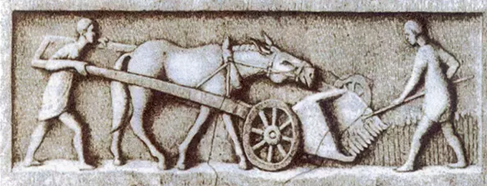
The Romans also used extensively utilized mills (found all overModern France and Italy), to grind wheat into flour. The most impressiveremains of these Roman innovations can be seen today in Barbegal, France, inwhich 16 overshot water wheels arranged into 2 equal columns were purposefullypositioned in order to be fed by the main Roman aqueduct. The water would pourdown into a certain mill, which then also acted as the supply for the next onedown in the series also.
The Romans also used extensively utilized mills (found all overModern France and Italy), to grind wheat into flour. The most impressiveremains of these Roman innovations can be seen today in Barbegal, France, inwhich 16 overshot water wheels arranged into 2 equal columns were purposefullypositioned in order to be fed by the main Roman aqueduct. The water would pourdown into a certain mill, which then also acted as the supply for the next onedown in the series also.
Rome’s Agricultural production however falls slightly short oftheir rivals’ supposed numbers, which has previously once been claimed beforeto have lain somewhere in the vicinity of 16 billion kg of wheat per year, ormerely 1.8% more than Rome. Said to have led both the world in annual grainyields at a absolute and per capita level, this would have amounted toapproximately 280 kg of wheat per person, or roughly 11% more than their Romancounterparts.
Abetted by the perfection also of Cast Iron tools from before,the Han saw major advances in Agricultural technology with regards to theChinese invention of the “Multi-Tube Seed Drill”, pictured down below asfollows:
罗马人还广泛使用磨坊(在现代法国和意大利都有发现)将小麦磨成面粉。这些罗马创,最令人印象深刻的遗迹今天可以在法国巴尔贝加看到,其中16个排列成2列的水轮被有目的地定位,以便引入罗马主水道系统的供水。水则会导入到一个特定的磨坊,而这些水也可以作为下一个磨坊的供水来源。
这玩意大概运行了200年,估计每天可生产4.5吨面粉。这足以为临近的阿莱拉特镇提供粮食了,阿莱拉特有大约3-4万居民。
然而罗马的农业产量任然要略低于(汉朝)其竞争对手的预期产量,之前有流言声称(汉朝)每年出产接近160亿斤小麦,或者说比罗马高出1.8%。据说这(些数据)致使世界人均粮食产量都达到了绝对的人均水平,这意味着人均小麦所得量接近280kg,人均所得量大约高出罗马11%。
彼时完美的铸铁工具也广受赞赏,汉朝见证了农业技术的重大进展,彼时中国人发明了“多管播种机”,如下图所示:
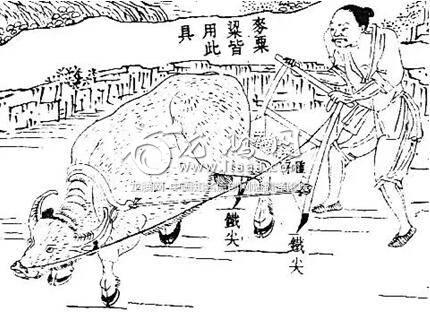
It was a revolutionary tool which made the sowing of seedsquicker, more efficient, and less time consuming. And it was directly as aresult of this innovation, that production yields were maximized thus acting tosustain population growth henceforth.
The Han Dynasty however, did not only invent the Multi Tube SeedDrill to help them in the areas concerning Agricultural production, butlikewise also innovated the concept of the “Replacement/Alternating Field” or“Daitianfa” (代田法) Method of Farming, in which fields were divided into multiplelong narrow trenches, making it easy for the various seeds to be placed intothose said trenches.
In addition, the soil that fell from the mountain tops on whichthe trenches were placed, supported the stalks of the various new plants. As aresult, this method also made it easier to water. It was a development whichallowed Intensive Farming to emerge first in China, before it did in the RomanEmpire. The Chinese invention of the Wheelbarrow around 100 AD likewise,further acted to make Han Agricultural productions more efficient, by making iteasier to travel back and forth during in the intervals between each individualharvest.
A reconstruction of the Chinese invention of the wheelbarrow,originating back to the Early Han Era:
这种器具是革命性的,它的出现使播种更加快速、高效且省时。这种创新带来的直接结果,那就是作物产量的最大化,此后的人口持续增长。
然而,汉朝不仅发明了多管播种机来提升农业产量,同样的,也发明了“代田法”这种农业概念,这种方法将田地分割成多个狭长的壕沟,从而各种种子更容易放进上述的壕沟。
此外,山顶上的由于壕沟的存在,土壤从上面落下去,带来了各种作物的秸秆。而这种方法使浇水也更为容易。这一发展,使集约化农业第一次出现在中国大地,比罗马要早。中国大约在公元100年发明了独轮手推车,这使收获季节的来回的移动更加容易,进一步提升了汉代农业生产的效率。
以下重现了中国人发明的独轮车,起源于汉代早期:

An all new plough was also invented during the Han Era whichrequired only 1 man to control it, 2 oxen to pull it, and was complemented with3 plowshares, a seed box to collect the drills, and a tool which turned downthe soil. This new discovery hypothetically allowed the Chinese to sow apotential 45,730 m^2 in a single day.
Verdict: Tough call, but a point should probably be awarded to theforemostly agriculture centric society of Han, which had also even went so faras to place the farmer near the top of the social hierarchy, second only toImperial Official. Furthermore, it should already be self evident that the Hanmade several more important discoveries to the fields to Agriculture than theirWestern counterparts did. Rome and Han: 1 all.
汉朝时期还发明了一种全新的耕犁,只需一人、两头牛便可操控,并配备了三个犁头,一个种子盒,另外还有一个翻土的装置。这一新发明据说可以使中国人在一天内播种45730平方米。
结论:有点左右为难,但是应该给汉朝一个“最重视农业”社会的称号,汉朝甚至将农民置于接近社会阶级的顶端的位置,仅次于帝国官员的存在。说到现在,应该已经不言自明吧,汉朝在农业领域比西方国家有更重要的发明。此轮,罗汉与汉朝,比分为1:1
Hydraulics and Mechanics
The Hierapolis Sawmill was probably one of Imperial Rome’sgreatest innovations in the realm of Mechanical Engineering. The sawmill, locatedin Asia Minor, was water powered and considered still to this day to be theearliest machine in the world to feature a “Crank and Connecting Rod”mechanism. It greatly assisted the Romans in converting wood, into lumber.
An artist’s impression of the Hierapolis Sawmill, anotheroriginal Roman Invention:
水利与机械
在机械领域,水力锯木厂应该是罗马帝国最重要的发明了。这种锯木厂位于小亚细亚半岛,用水力驱动,至今为止,应该是世界上最早的带有曲柄和连杆的机械了。极大的帮助了罗马将树木转变为木材。
希拉波里斯锯木厂还原图,另一项罗马原创发明:
It was precisely due to the invention of a Crank and ConnectingRod mechanism, which in time would also lead to the creation also of SteamPower. Created by a Greek Mathematician known today as Hero of Alexandria, hisinvention; the Aeolipile, was considered to be far ahead of its time, as properSteam Power wasn’t invented until at least 1698, with the advent of the SteamEngine.
The way in which it worked, was that a bladeless turbine wouldspin, when the central water container was heated. Torque as a result, wasproduced by the resulting steam which exited from the turbine, reflecting aphenomena still evident today with Jet engines.
An illustration of Hero’s Aeolipile:
正由于曲柄连杆机构的发明,导致了蒸汽动力被创造出来。人称“亚历山大英雄”的希腊数学家发明了:汽转球,这在当时被认为是遥遥领先的发明。因为直到1698年,随着蒸汽机的出现,蒸汽动力才被发明出来。
它的工作方式:当中央水容器被加热时,无叶片涡轮机将旋转起来,蒸汽机排出的蒸汽产生力矩,今天我们所见的喷气式飞机引擎也能反映这种现象。
以下是“亚历山大英雄”的汽转球还原图:
Though the Romans didn’t invent the Steam Engine themselves,they did however most notably already have the means to construct oneregardless based on this knowledge.
Apart from the earlier innovations of the Hierapolis Sawmill’sCrank and Connecting Rod Mechanism, and now also Steam Power derived from theAeolipile, the Romans also had intimate knowledge regarding the existence of aCylinder and Piston (used by metal force pumps), aside from non-return valves(utilized by water pumps) and gearing also (which water mills and clocks used).
All the five elements necessary to create a full, working SteamEngine as such, were already in existence by this point in time, long beforesuch a status quo was replicated by their Chinese rivals, on the far side ofthe world, many hundreds of years later.
Rome’s utilization of the Crane meanwhile, also reached itsheyday in the Imperial Era, an image of which can be seen below in thisparticular case of a “Pentaspastos”, or Five Pulley medium sized Crane, whichcould carry a 450 kg load:
虽然罗马没有自己发明蒸汽机,但是很明显他们已经可以通过这种知识建造一个了。
除了早期水力锯木厂中发明的曲柄和连杆机构之外,蒸汽动力也是由汽转球衍生出来的,罗马人对气缸和活塞的存在也有深入的了解(用于金属力泵),此外他们还很了解回流阀(用于水泵),另外还有齿轮(用于水力磨坊和钟表)。
彼时,创建一个完整的、可运行的蒸汽机的所有所需部件都已存在,这比其竞争对手中国复制这种技术要早很久,世界另一端的中国,几百年后才出现这类东西。
与此同时,罗马对起重机的利用也达到了帝国的巅峰时期,下图可见一个叫“Pentaspastos”的装置,或者叫它“五滑轮起重机”,这种器械足以承载450公斤的荷载。
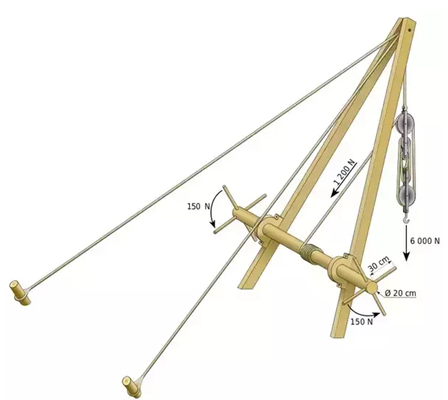
Even the simplest Roman Crane however, the Trispastos had amechanical advantage of 3:1 as it came equipped with three pulleys. Assumingthat the average fully matured adult man could lift say 50 kg, then this is tosay that the aforementioned pulley could help him displace a weight amountingto 150 kg.
The largest of the Roman Cranes however, the 10.4 metre highPolyspastos, had 5 pulleys and needed to be crewed by 4 different individuals,which would then allow them to lift a potential 3,000 kg. It could have evenlifted up to 6 tonnes however if the appropriate adjustments were made.
A photo below depicting the large Roman crane known as thePolyspastos:
即使是最简单的罗马起重机---“Trispastos”也具有3:1的机械优势,因为它配备了三个滑轮。假设一个成年男子可以提起50公斤,那就说是,前文提到的滑轮能帮助他们吊起重达150公斤的重量。
然而,罗马最大的起重机---- 高达10.4米的“Polyspastos”拥有5个滑轮,需要4个成员来操纵,可吊起3000公斤。如果对其做一些适当的调整,重量甚至可以提升到6吨。
下图显示了一个巨大的罗马起重机,人称“Polyspastos”:
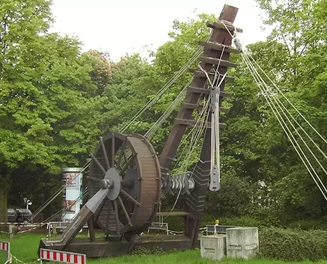
When compared to say Ancient Egypt for example, where 50 menwere required to lift a 2,500 kg load up a ramp, the Polyspastos allowed oneindividual to quickly and easily lift 3 tonnes worth of materials, greatlyincreasing efficiency when it came to matters of construction.
In the East meanwhile at this point in time, the Han Chinesewere also quite busy at work with their own contributions in the areas ofMechanics and Hydraulics.
The mechanical Belt Drive for example, was first introduced toHumanity by the Han Dynasty of China. The belt was an important innovation, asit was then used to assist in the winding of silk fibres, onto the bobbins ofweaver shuttles.
Speaking of which, the “Loom” had also first appeared onto thestage of the world by this point in time. Importantly, it would sooner ratherthan later be used to create the exotic material known as Silk, en masse. Silkwould of course later go on to contribute to the vast wealth of China forthousands of years to come.
A historical depiction of the Han invention of the loom:
比如跟古埃及相比,古埃及用50个人才能将2500公斤的负荷移动到坡道上,罗马的“Polyspastos”只需一人便可迅速、不费吹飞之力吊起3吨材料,这极大地提升了基建效率。
而在东方,中国人在为机械与水利的领域努力地贡献自己的力量。
比如机械皮带传动,就是由中国人在汉代你首次带给人类的。皮带是一项重要的发明,被用来将蚕丝纤维盘绕到织布机的梭子上。
说到这里,彼时,织布机也第一次登上世界舞台。更重要的是,它迟早会用于创造一种其他的材料---那就是丝绸。而这之后的几千年里,丝绸无疑会为中国的巨大财富做出重要贡献。
历史里描述的汉代织布机:
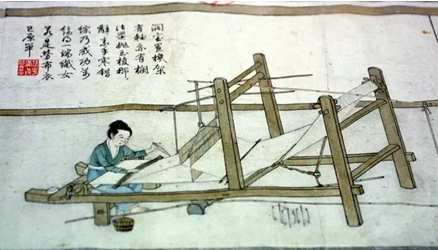
The Seismoscope meanwhile, was probably one of the greatestinventions of the Han Dynasty during China’s Early Imperial Era. Earthquakes,which had long plagued Sino civilization from time immemorial, often (asEarthquakes do) strike without warning, and were always highly catastrophic.
Naturally in response to such an annoying threat, a ChineseAstronomer known as Zhang Heng invented the Seismoscope in order to detectwhich direction an Earthquake had, or was currently occurring in, in order toquickly direct relief efforts to the affected areas immediately. In 132 BC forexample, it successfully detected and identified an Earthquake which wasoccuring 500 km in a specific direction, despite the fact that no tremors couldbe felt at the time.
A photo depicting Zhang’s device below (equipped with a “Crankand Catch” Mechanism, whenever an Earthquake was detected from afar, aninverted pendulum would swing to 1 of 8 directions. In response, a metal ballwould then drop into a frog’s mouth, to indicate the direction in which anEarthquake was currently occurring):
与此同时,简易地震仪,可能是中国早期帝国时期---汉代,最重要的发明。长期以来一直困扰着中华文明的地震,经常(地震确实是这样)毫无征兆的发生,而且通常是灾难性的。
为了应对这种恼人的威胁,一位中国天文学家—张衡发明了地动仪,用于探测地震发生的方位,或者是目前发生地震的方位,以便迅速赶往灾区开展救灾工作。比如在公元前132年,它就成功的探测到一次地震,这次地震发生于500公里以外的特定方向,尽管当时无人可感觉到震感。
下图显示了张衡发明的装置(装备了“曲柄和抓手”机构,每当远处发生地震时,倒立摆将摆动到8个方位之一处,从而,一个金属球将掉至青蛙的嘴里,用以指示当前发生地震的方向):

Both the Romans and Han however, shared two things in commonwith regards to the field of Mechanical and Hydraulic Engineering: they bothused water mills and chain pumps throughout the duration of their respectiveempires. In the case of the Roman Empire, the set of aforementioned Water Millswhich were introduced back in the previous chapter, has been aptly described by21st Century Historians to be, “the greatest known concentration of mechanicalpower in the ancient world”.
The Han however, took Hydraulic developments one step further,by inventing both a waterwheel powered Mechanical Puppet Theatre which featuredmany self moving automatons, and also the water clock. The water clockfunctioned in that it measured the passing of time, based on the regulated flowof liquid into, or out of a container.
The Han Era Water Clock, used by the Imperial Chinese to measurethe passing of time and was made out of Bronze:
在机械和水利工程方面,罗马和汉朝都展现了2个共同点:二者在各自的整个帝国期间,都使用了水力磨坊和链泵。罗马帝国方面,上一章节中介绍的这一套水力磨坊,被21世纪的历史学家描述为:古代世界里最伟大的机械力量教科书。
然而汉朝,将水利工程的发展带入了一个新高度。汉朝发明了水轮车驱动的水傀儡,以及水车驱动的时钟。水钟的功能在于它能根据调节流入或流出容器的液体流量来测量时间的流逝。
以下为汉代水钟,皇家用其来测量时间的流逝,由青铜制造:
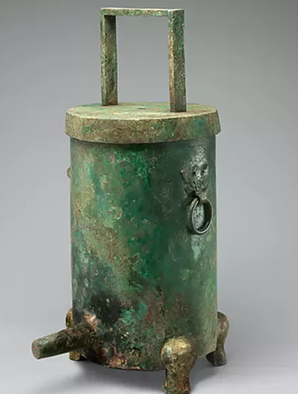
The creator of the Seismoscope, Zhang Heng was also the first toaddress the issue of the falling pressure head, with regards to the inflowwater clock (which gradually slowed the timekeeping process over time) bysetting up an additional tank between the reservoir and inflow vessel.
The creator of the Seismoscope, Zhang Heng was also the first toaddress the issue of the falling pressure head, with regards to the inflowwater clock (which gradually slowed the timekeeping process over time) bysetting up an additional tank between the reservoir and inflow vessel.
Rotary fans most notably also led to the invention of theWinnowing machine, where they were actively also utilized, to separate grainfrom the casing of their seeds. A crank handle and tilt hammer was used toachieve this. Ideally, a cranked fan was to produce an airstream in order topower the utilized rotary fan, which in turn would be used on the harvestedgrain afterwards.
Rotary fans most notably also led to the invention of theWinnowing machine, where they were actively also utilized, to separate grainfrom the casing of their seeds. A crank handle and tilt hammer was used toachieve this. Ideally, a cranked fan was to produce an airstream in order topower the utilized rotary fan, which in turn would be used on the harvestedgrain afterwards.
地动仪的缔造者---张衡,通过在储水器和流入容器之间设置额外的储水罐,率先解决了水钟内水压压力下降问题(随着时间的流逝会逐渐减慢计时过程)
汉代的一种类似空调原型的装置也得到了发展,这种装置改良后为中国精英阶层所用。大型手动旋转式风扇配备了水轮,有时偶尔还能以水打湿大厅的人们,用以降温。
旋转式风机最引人注目应用的还是风选机的发明,它用处还是很大的,可将谷物与其谷壳分开。采用曲柄加上杵锤来实现这种功能。理想情况下,曲柄风扇所产生气流从而驱动旋转风扇,该旋转风扇随后将用于收获的谷物(分离谷壳)。
下图可见汉朝时期出现风选机模型:
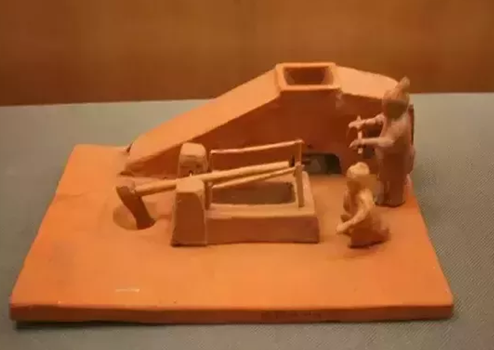
Verdict: Although the Han definitely made more contributions in thisparticular area, the Romans made quite a couple of highly importantdevelopments also, and thus their capabilities can be considered to have beenequal. The steam powered machine for example, was unbelievably advanced for itstime. Still, the same could technically be said for China’s contributions inthese fields also. Rome: and Han: 2 all.
结论:虽然在特定领域,汉朝的贡献明显更多,但罗马在做出了一些非常重要的发展,所以这哥俩的能力应被认为是差不多的的。比如蒸汽动力机械,在那个时代来说,足以先进到令人惊掉下巴。当然了,中国在这些领域的贡献也是如此。所以此轮,罗马与汉朝,比分为2:2
Medicine
Because the Romans were not so expertly skilled at Medicinethemselves, they often had to borrow experts and field knowledge based on theworkings of the Ancient Greeks. Nonetheless, they were still able to producesome prominent figureheads such as Galen, or Celsus.
Roman Medicine at its heights, was characterized by an everexpanding knowledge on the fields of practical medicine, and saw great advanceswith regards to the field of Surgery. From the second century AD, literarytexts contributed to by many physicians known as the “Medici”, allowed Rome toassist in their understanding of which herbs were appropriate for a specificailment.
Ippomarathron or Fennel for example was known to cure cases ofpainful urination, internal disorders such as stomach pains were meanwhilesuppressed using Ra (Rhubarb), Aristolochia (Birthwort) was used to easebirthing pains, Aloe for wounds and Glikoriza (Liquorice) for calming internalorgans.
Reliefs from well preserved archaeological sites such asPompeii, have been known to have provided experts with tangible evidence,regarding the use of forceps, tweezers, wound retractors, collecting cups,needles and various sized scalpels to assist Roman doctors in surgery.
Roman Surgery tools, commonly used during the first and secondcenturies during the Early Roman Empire:
医学
由于罗马人本身对医学并不熟练,他们经常需要向外部借用一些专家和医学学问,这些学问基于古希腊人的知识,尽管如此,他们仍然出现了一批杰出的医学家,比如盖伦。
罗马的医学,其特点在于实用医学领域的知识不断扩大,在外科领域取得了巨大进展。从公元二世纪开始,许多被称为“Medici”的医生对医学文献作品做出了贡献,这也帮助了罗马人理解何种草药适用于何种特定的疾病。
比如茴香,世人都知道可以治疗小便涩痛,内脏疾病比如胃痛则可以用大黄来治疗,马兜铃可以用来缓解分娩之痛,芦荟用来治伤口,甘草可用于镇静内脏。
众所周知,一些保存完好的考古遗址,如庞贝古城为专家提供了有关使用钳,镊子,伤口牵开器,收集杯,针头和各种尺寸的手术刀以协助罗马医生进行手术的实际证据。
罗马的手术器具,在早期罗马帝国时期的第一、二个世纪里是很常用的器具:

Using such tools, Roman doctors could perform a wide variety ofsurgeries, including but certainly not limited to: cataract removal, drainingof fluids, trephination, and sometimes even the reversals of circumcision. Itshould be noted however, that like in most other societies at the time, Surgerywas considered to be a last resort, due to the risks involved in such adangerous and unsanitary practice at the time, giving rise to infectionspost-operation.
The first hospitals to appear in Italy were also introducedduring the course of the Roman Empire, alas they were usually only reserved forslaves and soldiers however. Valetudinaria as they were called, were mainlyrectangular and accompanied with 4 wings at any given time. Their maximumcarrying capacity could accommodate up to 500 men, or 10% of an ImperialLegion.
A plan for a Roman Valetudinarium, near Düsseldorf, Germany,dating back to the late 1st century AD:
用这种器具,罗马医生能实施各式各样的外科手术,包括但不限于:去除白内障,排除液体、环钻术、有时甚至能还原割礼。然而应该指出的是,与当时大多数其他社会一样,手术被认为是最后手段,因为手术比较危险,且彼时的卫生状况堪忧可能导致感染,所以风险很大。
在罗马帝国时期,在意大利出现了第一批医院,虽然他们只是用来为奴隶和士兵服务的。一种被称作“Valetudinaria”的医院,通常是矩形的,带有4只翼。最大的病员容量高达500人,大约是一个帝国军团的10%。
罗马的“Valetudinarium”还原图,位于德国杜塞尔多夫,可追溯到公元1世纪:

Roman physicians by this point in time, were also self-aware oftheir own limitations however, with regards to the treatment of certain wounds.Serious injuries to the brain, heart, liver, spine, intestines, kidneys andarteries for example, were widely considered by many at the time to have beenbeyond the expertise of many physicians alike.
Roman Medicine, often defined by common sense and supremepracticality, was sometimes also negated by a lot of pseudoscience at best, andobsolete practices at worst. Doctors would for example interpret a patient’sdreams in order to decide on what treatments a sick person would receive.Furthermore, was the Roman belief that drinking blood fresh from a recentlyslain Gladiator, would cure epilepsy. Needless to say, these treatments wereusually redundant.
On the bright side however, the Romans did also correctlyhypothesize (based on Greek knowledge retrieved from renowned Hellenicphysician, Hippocrates) that the key to living longer lay at the base of a wellbalanced diet. Thanks to the efforts of Galen meanwhile, bandages weresterilized in wine first before being applied onto an injury.
Traditional Chinese Medicine (TCM) meanwhile, used still to thisvery day in certain parts of the world, was also likewise utilized during theHan Dynasty 2,000 years ago. Whether there is or is not evidence for theeffectiveness of TCM of course however, remains highly controversial even tothis very day.
Acupuncture (the inserting of needles in order to accelerate thebody’s natural healing processes) was and still is one of these aforementionedcontroversial practices (practitioners of Acupuncture today have claimed thatmany physical and mental illnesses, can be cured by such a practice. Naturally,many others are quite sceptical of such claims, but it presumably would havealso acted well as a placebo, which has been scientifically proven to sometimesbe just as effective as the genuine cure), an acupuncture chart depicting thewhereabouts of an individual’s “Meridian” lines, are seen below as follows:
彼时的罗马医师,也能意识到自己医术的局限性,然而对于某些伤口的治疗方面,比如脑补、心脏、肝脏、脊柱、肠道、肾脏、动脉这些器官的严重损伤,诸如此类的疾病在当时,会被认为已经超出了许多专业医师的知识范围。
罗马医学通常由常识和实用性来定义,不过有时也被吐槽:最擅长伪科学,而摒弃实践。
另一方面,罗马人也正确提出了一个正确的假设,那就是保持均衡的饮食习惯是可以延长寿命的(基于希腊名医的知识)。同时,由于盖伦(古罗马医师)的努力,绷带在用于处理伤口之前首先要在葡萄酒中消毒。
而传统中医(TCM),在世界某些地区任然被沿用至今,其在2000年之前的汉朝也有应用。当然了,传统中医是否有效的证据,至今仍存在争议。
针灸(插入针头以加速身体的自然愈合的过程),任然如上述所说那样,存在争议性(如今的针灸从业者宣称,许多生理与心理疾病都能用针灸来治疗。自然的,也有许多人怀疑这番言论。但它大概可以作为安慰剂而发挥功效,已被科学证明有时与真正的治愈效果一致)。描述人体“子午线”分布的针灸图如下所示:

But apart from these possible trivialities, the Han Chinese alsomade many notable practical contributions to the fields of Medicine however.Pulse diagnosis for one, was practiced by the physicians of the Han Dynastywhich understood that an individual’s health could be ascertained merely bymeasuring their heart rate.
Because of this discovery, it allowed them to recognize that ahealthy person was one who had a low resting heart rate for example. Not onlythat, but this also allowed them to often guess which treatments were requiredto nurse an individual of poor health, back to optimal standards with regardsto physical condition.
Practical advice meanwhile, was given in regards to the act of“Clinical Lancing”, in order to remove an abscess. A Medical text known as the“Yellow Emperor’s Inner Canon” (黄帝内经) meanwhile,recognized the medical phenomena of the Circadian Rhythm; a biological clockknown to have repeated itself every 24 hours or so. The text also noted thesymptoms and reactions of people with various diseases of the liver, heart,spleen, lung, or kidneys in that aforementioned 24-hour period.
Aside from these practical treatments however, other morequestionable cures which were said to have allowed for the better flow of bloodthroughout the Human body, also existed at the time, chief amongst which wasthe practice of Moxibustion (a process where dried plants are burnt near thesurface of the body, with the intention to also dispel certain pathogenicinfluences):
除了这些可能有些琐碎的事之外,汉朝人也对医学领域做出了许多显着的实际贡献。把脉就算其中一致,汉朝医生对病人把脉,通过测量心率来确定个体的健康状况。
由于这项发现,他们认识到,一个健康在平静的时候心率应当是比较低的。不仅如此,这让汉朝医师能针对健康状况差的病人选取不同的治疗手段。
同时,对于临床手术来说,也提供了一些实用建议,比如去除脓肿。有本书叫《黄帝内经》,这本书认识到医学现象的昼夜节律;生物钟大约24小时自身循环一次。这本书还介绍了各种疾病24小时里的的症状与反应,比如肝病、心脏病、脾脏病、肺病或者肾病。
除了这些实践治疗以外,当时也存在其他更令人怀疑的的治疗方法,据说可以使整个人体更好的血液流动,其中最主要的是艾灸(在身体皮肤的附近燃烧植物,目的是为了消除某些病灶的影响。):
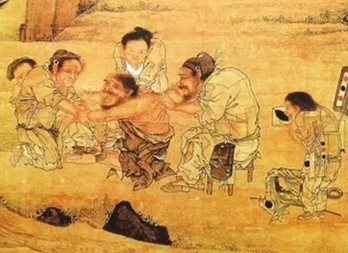
Still, it was through the efforts of a Chinese physician, ZhangZhongjing who much like his Roman counterparts also notably suggested that poorhealth was as a result of bad dieting, and in followed up in his medical text,the “Essential Medical Treasures of the Golden Chamber” (金匮要略) with advice onwhich foods were rich in which vitamins, in order to treat illnesses naturallywith the resources of nature.
Another Chinese physician known as Hua Tuo, who had studied theYellow Emperor’ Inner Canon, used it to develop a form of anesthesia, which hethen applied to be used for surgical purposes. In addition to that developmenthowever, he also innovated a very particular type of cream which was recordedas having the ability to heal surgical wounds within a month’s time. And yet inanother recorded example, he correctly identified a premature fetal death,which he then removed, curing the mother of her ailments.
Physical exercise meanwhile, was upheld by the Han (much likethe Romans) as a way to stay naturally fit and healthy. Calisthenics wereupheld in the Han Dynasty, as mentioned in the Chinese philosophical books, the“Mawangdui Silk Texts” (马王堆帛书), which originally hadmany detailed images depicting the most appropriate forms of exercise toincorporate into one’s daily routine, in order live by a healthy lifestyle.Both Qigong and Taichi to this day, are considered to have been derived fromHan Era Calisthenics.
Verdict: When the nonsense half from both civilizations’ understandingof Medicine is taken away, it would appear at first that the two were roughlyequal. But due to the existence of hospitals, and a seemingly superior surgeryknowledge, Rome slight edges out the Han Empire here. Which is not to say thatthe Chinese were necessarily inferior however, it would seem that Chineseunderstanding of natural medicine, often studied at an official level, edgesout their Western counterparts. Rome: 3; Han: 2.
不过,中国医生---张仲景,有点像罗马竞争对手那样,也意识较差的健康状况是由于不好的饮食习惯造成的。张仲景通过努力,编写了自己的医学典籍,那就是《金匮要略》,《金匮要略》推荐了富含维生素的食物,目的是通过自然的资源,自然地治疗疾病。
另一位中国医生—华佗,他研习过《黄帝内经》,并发展出一种麻醉剂,然后将其用于外科手术领域。除此之外,他还创造了一种非常特殊的霜剂,这种霜剂据记录能够在一个月内治愈手术伤口。
汉朝还推崇体育锻炼(这点有点像罗马),通过锻炼来保持自然和健康。徒手体操在汉代广受推崇,中国的哲学书籍---马王堆帛书就有提到,用许多详细的图像描绘了最恰当的锻炼形式,并将其融入日常生活中,从而以健康的生活方式生活。今天的气功与太极,被认为是从汉代徒手体操演变而来。
结论:当去除掉两个文明中对医学的那些荒谬理解之后,我们会发现,二者(在医学领域)大致相当。但是根据医院的存在、以及更高级的手术知识来说,罗马大概比汉朝高明那么一点点。当然也不是说中国差,我会说,中国人更加理解天然药物,而且经常有官方层次的医学研究,这点就比其西方竞争对手要厉害一点。这一轮,罗马与汉朝,比分为3:2.
Astronomy
As the oldest of the natural sciences, Astronomy has had quitethe long and varied history in both the Roman and Han Empires alike.
The Roman astronomer Ptolemy, was said to have not only studiedthe motions of the heavenly bodies in depth, but had also mapped out roughly1,000 different unique stars. Throughout the duration of Imperial Rome,Sundials were already being used to measure the passing of time, and couldusually be found in most major towns. From the volcanic ashes of Pompeii alonefor example, 35 sundials have been retrieved in modern times by archaeologistsexcavating at the site.
A photograph depicting a Roman Sundial as can be seen below:
天文学
作为最古老的自然科学,天文学在罗马与汉朝都一样,拥有长久而多样的历史。
罗马天文学家—托勒密,据说不仅深入研究了天体的运动,而且还绘制了约1,000个不同的独特恒星。在罗马帝国时期,日晷就已经被用来记录时间了,通常在大多数主要的城镇都能找到这玩意。例如,从庞贝古城的火山灰中,现代考古学家发掘出了了35个日晷。
下图显示了罗马日晷:

Although he wrongly insisted that the Earth stood still, whilstthe Sun moved around it, Ptolemy did however understand the conceptual notionsof “Retrograde Motion”, the observation that despite the fact that planets inthe night sky only rotated around the Earth in one direction, occasionally theywould also appear to journey backwards.
He also subsequently followed up such observations with aplethora of complicated mathematical equations, in order to predict when eachplanet would go into retrograde motion. The Roman historian Cassius Diomeanwhile, records the observations of Halley’s Comet by Roman astronomers.
Most notably, the Romans also knew that the Earth was round.Sailors were already using the stars to navigate the High Seas, and contrary toPtolemy’s own beliefs, certain Roman astronomers had already correctlyhypothesized, that the Earth went around the Sun, rather than vice-versa. TheJulian Calendar meanwhile recorded a year as being 365.25 days long, dividedinto 12 months in a year.
A later European Star Chart based on Ptolemy’s work:
虽然托勒密错误地坚持认为:地球是静止不动的,而太阳是围绕地球转动的。但托勒密却理解了“天体逆行运动”的概念。即观察到尽管夜空中的行星只是绕着地球在一个方向上旋转,但偶尔它们也会出现向后退的情况。
随后托勒密还通过大量复杂的数学方程来跟踪这些观测,以便预测每个行星何时会进入逆行运动。与此同时,罗马历史学家卡西乌斯·狄奥还记录了罗马天文学家对哈雷彗星的观察。
而最重要的是,罗马人还知道地球是圆的。水手们已经能利用星星来导航从而在公海上驾船。与托勒密自己的信仰相反,某些罗马天文学家已经正确地假设:地球围绕太阳而不是反过来。与此同时,儒略历记录到一年为365.25天,分为12个月。
之后的欧洲星图,基于托勒密的着作:
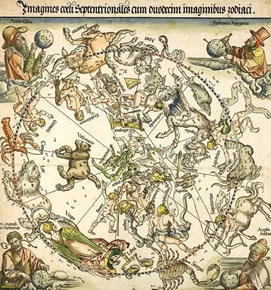
Han Chinese achievements meanwhile in the realm of theAstronomy, were at least as equal to their Western counterparts. The Chineseastronomical text, the “Miscellaneous Readings of Cosmic Patterns and PneumaImages” (天文气象杂占), made many detailed, visual depictions ofroughly 300 different climatic and astronomical features including clouds,rainbows, stars, constellations, and comets.
A comet which was observed in the Parthian Empire (247 BC–228AD) at the time of the birth of Mithradates II (the same one which theRepublican Romans had also observed prior to the assassination of JuliusCaesar), was also likewise spotted by Chinese Astronomers in 135 BC.
The Han much like their Roman counterparts were also known tohave used the Armillary Sphere (having invented the water powered variantthemselves), in order to be used as a model for the Heavens above, the linesaround the spheres represented the notions of Longitude and Latitude. Shownbelow is the variant designed by Astronomer Zhang Heng (who also invented theSeismoscope mentioned previously):
而汉朝在天文学方面,至少与西方同行有相同的地位。中国天文学着作—“天文气象杂占”一书,其中有很多细节描述,大约对300种不同的气候和天文特征进行了视觉描绘,包括云,彩虹,星星,星座和彗星。
帕提亚帝国时期(公元前247年-公元228年)米特里达二世生日梯发现了一颗彗星(在朱利叶斯凯撒被刺杀之前,罗马共和国发现的也是这颗彗星),中国天文学家在公元前135年也发现了。
汉朝与其竞争对手罗马很像,他们也使用了浑天仪(汉朝还自行发明了水力驱动的的改进型),为了用于展示天空的模型,浑天仪上的线条代表了经度与纬度。下图展示了天文学家张衡设计的浑天仪变种(前文所提到的地动仪也是他发明的):
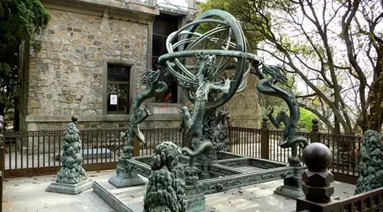
Halley’s comet, mentioned before as being accounted for byCassius Dio, was likewise spotted by the Han Chinese, roughly 25 years beforetheir Roman contemporaries back in 12 BC. What is now known to be a Supernova ,was also likewise known to have been observed by Han astronomers in 185 BC.
Various comets were also discussed with regards to theirpositions in the sky, and which direction they were then currently moving,along with their colour, size, and for how long a period of time they werevisible; all of which were recorded by the Chinese Historian, Sima Qian in histext, the “Records of the Grand Historian” (史记).
Zhang Heng’s works in accounting for the stars, allowed him toaccount for 2,500 different stars (as opposed to Ptolemy’s 1,000 observedstars), along with 124 constellations, an effort which had been aided by SimaQian in his text, “A Monograph on Celestial Officials” (天官书).
And as for official Taichu Calendar (太初历) which was usedofficially by the Han Chinese meanwhile, whilst not as accurate as the JulianCalendar, still manage to calculate the tropical year, approximating it to 365.385/1539 days, whilst asserting that the duration of the lunar month was 29.43/81 days. Before long however, the former Sifen Calendar (古四分历), which hadbeen introduced roughly 600 years prior by that point in time, was re-adoptedby the Chinese, which made the same estimates as its Julian counterpart haddone in the West, with regards to the length of a specific month and year.
Like their Roman counterparts, the Han Chinese also made fulluse of Sundials as well (this particular one was retrieved from Inner Mongolia,dating back to the 2nd Century AD):
前文所提到的哈雷彗星,由卡西乌斯·狄奥所记录,也被汉朝人发现了,大约比罗马早25年,可追溯至公元12年。现今所知的超新星(现象),汉代天文学家在公元前185年就已经观测到了这种天文现象。
关于各类彗星在天空之中所处位置、现今其运动的方向,诸如此类话题也被广泛地讨论,并描述了各种彗星的颜色、尺寸以及多长时间能见到一次;所有这些都被中国历史学家所记录,比如记录在司马迁的着作《史记》中。
而张衡的工作则是记录星象,由此他记录了2500个不同的星体(而不是托勒密的观察到的1000颗恒星),外加124个不同的星座,这是司马迁在其着作《天官书》中所提到的。
至于官方的太初历,此历由汉朝官方所用。此历虽然不如儒略历精准,但任然成功计算出一年大约有365.385天,同时还估计出农历月的时间是29.43天。不过不就之后,之前600年前所用的“古四分历”又被中国人重新采用,这款历法与其西方竞争对手儒略历所估算的每月/每年的数据一致。
与罗马一样,汉朝人也充分利用了日晷(这个日晷是从内蒙古发掘的,可追溯至公元2世纪):
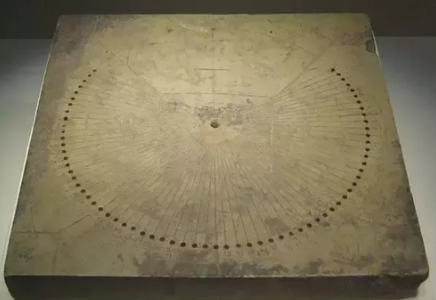
Similar to Ptolemy however, the Han believed incorrectly in aGeocentric Model of the Solar System. Though the Chinese did not know that theEarth was round unlike their Roman counterparts, thanks to the efforts of JingFang, a musical theorist, it was quickly understood that the Moon was onlybright since it reflected the light emanating from the Sun, a belief which wasalso shared by Zhang Heng.
Zhang in addition notedthat sunlight didn’t always reach the Moon, a phenomenon due to thefact that Earth would obstruct the rays during a Lunar eclipse.Solar eclipses, were also observed by the said Han astronomer, whereby sunlightwas prevented from reaching by the moon.
A common thought during the Han Dynasty that rain came from theareas beyond the Earth, was also disproved during this point in time, when anastronomer called Wang Chong argued in favour of an evaporation process, whererain came from water retrieved from the oceans instead, in his book, “BalancedDiscourse” (论衡).
Verdict: Due to the overwhelming number of quality discoveries made bythe the Middle Kingdom, this next point by far goes to Han China. The Chinesewould not have “steamrolled” the Romans, however there can be no doubt that itwould be they which should emerge victorious in the end. It seems veryself-evident that the Chinese was a Space oriented society, with a detailedknowledge of celestial mechanics. Rome and Han: 3 all.
与托勒密相似,汉朝对太阳系模型的认知也是错误的。尽管汉朝人相对于罗马人来说,并不知道地球是圆的。但是归功于音乐理论家京房的努力,京房很早就意识到月亮只有在反射了太阳光之后才会变亮,而张衡也持有相同的看法。
此外,张衡还指出,太阳光并不是总能到达月球,这是由于在月食期间地球会阻挡太阳的光线。这位汉朝天文学家还观测到了日食现象,日食期间,太阳光被遮挡而不能到达月球。
在汉朝时期,一个普遍的观点,那就是雨水是来地球以外的某处。而此时有人证明出这个观点是错误的,当时一位名叫王冲的天文学家认为这是一个蒸发过程,雨水来自海洋中的水,在他的着作《论衡》中就有提及。
结论:由于中央王国大量的高质量发现,天平目前为止向汉朝倾斜了。但中国人还没有“击败”罗马人,然而毫无疑问,最终应该得到胜利的是他们(汉朝)。不言而喻,中国是一个以空间为导向的社会,具有天体力学的详细知识。所以此轮为止,罗马与汉朝,比分3:3.
Naval Technology
Roman civilization by the time of the Empire had already hadquite a long and proud maritime tradition, even despite the fact that theRomans were often fairly suspicious of travelling by the sea, since theythought that it was always infested with ocean going monsters at any giventime. As a result, they often preferred to travel by land instead.
Nonetheless, Roman achievements with regards to Naval Technologycan neither be ignored nor underplayed. Shipbuilding to the Ancient Romans wasmore than just a mere science as it often perceived to be today, rather it wasan art first and foremost.
During the Imperial Era, the Romans abandoned their traditionalmethods of building the outer hull first, and instead replaced it with one usedstill to this day; constructing the frame of an ocean going vessel, beforeproceeding onto its hull and other crucial yet “secondary” components.Described to be a more systematic type of method, it dramatically shortened thetime required to adequately construct a solitary ship.
A reconstruction of a Roman anchor:
海军技术
帝国时期的罗马文明,已经有了相当长、引以为傲的海洋传统,尽管罗马人对海洋旅行经常持怀疑态度,因为他们总认为海洋怪物会使他们感染。因此,他们更喜欢陆地旅行。
尽管如此,罗马在航海科技上的成就,既不能被忽视也不能被淡化。古代罗马人对待造船,不仅仅是像今天一样,被认为是单纯的一门科学,更为重要的是,他们视之为一门艺术。
在帝国期间,罗马人摒弃了传统造船方---先造外壳,取而代之的是迄今仍在使用的方法:在制造船体和其他“次要”部件之前,先造出船体的框架。这是一种更加系统的方法,大大缩短了建造一艘船所需的时间。
罗马船锚重建图:
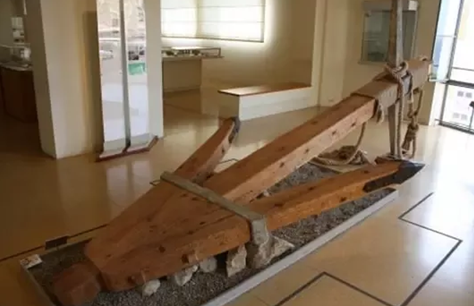
Warships meanwhile, were designed to be light, yet inhumanlyquick (due to the fact that it operated both on wind power and human labour)and better still, highly maneuverable. Each war vessel came equipped with abronze ram, which was used to smash into an opposing enemy ship, severelyacting to cripple or even, provided the damage was extensive enough, wholly sinkit. Underwater hulls meanwhile often came equipped with a ratio of 6:1 or 7:1.
The Trireme, traditionally the main war vessel of the RepublicanEra (509–27 BC), during Imperial Rome was largely superseded with the vastlysuperior Quadrireme and Quinquereme class warships of the Imperial Navy. Incontrast to the Trireme before which was merely crewed by 180 rowers, the RomanQuinquereme had the capabilities to house a crew of 300 rowers, accompanied by90 oars on each side.
A graphic below depicting the Quadrireme Class Battleship, withits two distinctive “forts” located at the vessel’s bow and stern:
同时,战舰被设计成轻型化,但却快得残暴(那是因为战舰采用了风力和人力双重动力),这样的方法更好,机动性比较强。每艘军舰都配备了一个青铜撞锤,这是用来粉碎地方船只的,可以瘫痪对方船只,如果损坏强度足够的话,甚至可以使地方船只完全沉没。同时,这种船只的水下船体部分的比例通常为6:1或7:1.
“Trireme”传统上是罗马共和国时代的主要战舰(公元前509-27年),但在罗马帝国期间,基本上已经被帝国海军极其优越的“Quadrireme”和“Quinquereme”级战舰所取代。与之前仅配备180人的“Trireme”级相比,“Quinquereme”级能容纳300名划手,船的两边各配备90个桨。
下图描绘了“Quadrireme”级战舰,其两个独特的“堡垒”位于船首和船尾:
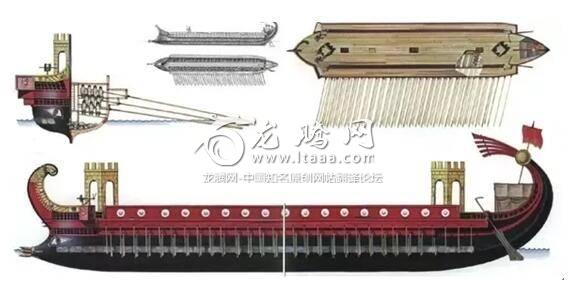
Speaking of which, the crew contrary to popular beliefs, was notmade of slaves, rather they were formed from the ranks of Roman citizens whohad signed up for the Legions, just like any other “normal” enlisted man. Thisdeeply serves to imply the professionalized nature of the Imperial Navy as awhole also in addition.
Anyways, with a length of 45 m, and a width of 5 m, it was ableto easily displace 100 tons of water, and was superior to the Republican EraTrireme with regards both to speed and the ability to perform to an excellentstandard in only the most treacherous of seas.
A mosaic from Tunisia depicting a Trireme Class Battleship,which was still used during the Imperial Era:
说到这一点,与大多数想法相反的是,船员不是由奴隶组成的,而是由报名参加军团的罗马公民组成的队伍,就像任何“正常”入伍的人一样。这也意味着整个帝国海军的专业化性质。
不管如何,一艘长45米,宽5米的战舰,其排水量是可以轻松达到100吨的。不管从速度方面、在最凶残海况下的表现来看,都要比共和国时代来得优越。
突尼斯的镶嵌画描绘了一艘“Trireme”级战列舰,在帝国时期任有使用:
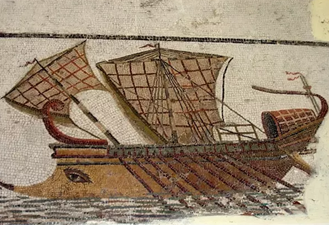
Roman military ships in addition were greatly aided in maritimebattles by a boarding device which was used to board hostile ships known as theCorvus. It was a movable bridge which could attach itself to an enemy ship,allowing the Romans to transfer their military experience on land, to theirmartial endeavours at sea. Naturally, this acted only to assure Romansuperiority on the High Seas all throughout the Imperial Era.
Merchant class vessels on the other hand, were just as likely tobe as advanced as their military cousins. Their underwater hulls were usuallysignificantly shorter, with a ratio in some instances of 3:1, speaking of whichwere also usually a lot deeper than the vessels of the military, disallowingthem often to sail close to the coastal regions. Merchants ships were also thenaval, vehicular equivalent of “Marathon” runners, thus they were built to alsobe efficient over long distances, constricting them thus in the sense thatneither speed nor maneuverability were a priority when it came to theconstruction of such vessels.
They also usually came equipped with two huge side rudderslocated off the stern, the likes of such which were controlled by a smalltiller bar linked to a system of connecting cables. And depending on the sizeof these said vessels, often possessed between 1–3 square shaped sails,complemented also by a smaller triangular variant known as the “Supparum” atthe vessel’s bow.
Carrying capacities often oscillated between 100–150 tonnes ofcargo, with the maximum limit allowing some vessels to have been able to holdup to 3,000 amphorae (liquid holding containers). Roman merchant vessels havebeen known to be able to carry up to 600 tonnes of cargo though it should benoted, or to put it another way; the rough equivalent of carrying on board12,000 amphorae. Such behemoths were estimated to be 46 metres in length,besting even the Quinquereme class battleship, which was exactly a metreshorter.
A model of a Roman Merchant Ship:
此外,在海战中,罗马军舰也得到了的登船装置的极大协助,这种装置曾被用来登上被称为“乌鸦座”的敌对船只,这让罗马人将他们在陆地上的军事经验,转化为他们在海上的军事行动。当然了,这只是为了确保帝国时代,在整个远海上的优势。
另一方面,罗马的商用船只大概与它的老表(应该指汉朝)差不多水平吧。其水下船体部分通常非常短,比例大概只有3:1,这与军舰比起来就深得多了,这样经常阻碍他们在近海地区航行。因为商船也是航海器具,也具备像汽车一样的马拉松选手的特质,因此在建造这样的船只时,既不能考虑速度也不无需考虑可操作性。
它们通常还配备了两个位于船尾的巨大方向舵,这些方向舵,由与连接了线缆系统的小舵杆控制。根据这些船只的大小,通常拥有1-3个矩形帆,并且在船首处,还配备了一个小号的三角形变体(帆),人们称之为“Supparum”。
而装载容量通常在100-150吨之间,最大的限度下,一些船能容纳3000个双耳瓶(装液体的容器)。罗马商船据闻可装载600吨货物,或者换句话说大概相当于能搭载12000个双耳瓶,这个数量也很可观了。据估计,这种庞然大物,长度达46米,甚至比“Quinquereme”级战舰还要长1米。
罗马商船模型:

Chinese Naval Technology on the other hand compared to theirWestern counterparts was relatively non-existent. The Romans, had already had anational standing Navy previously established in the year 311 BC, but itwouldn’t be for another 1,300 years during the Song Dynasty (960–1279 AD) untila similar maritime force was created by the Chinese to defend their coasts fromforeign invasions, and ruthless pirates.
Though the Han Chinese didn’t fear ocean travel as the Romansdid, they were mainly a landpower however and as such saw few improvements inthe realm of Naval Technology. An Early Han Era shipyard discovered back in1975 was said to be capable of producing ships for both the Merchant andMilitary navies, each of which was up to 30 metres long, 8 metres wide, andweighed 60 tonnes each. And yet another shipyard meanwhile was discovered tohave existed in Anhui province, which focused specifically on the creation ofmilitary vessels.
The “Junk” for the first time in Chinese history was meanwhileintroduced during the Han Era by the end of the 1st Century AD, and still tothis day is considered to be China’s earliest seaworthy naval vessel. The HanEra Junk had a square ended bow and stern (forcing them to sail in thedirection of the winds), a hull which was flat bottomed, and solid transversebulkheads as a replacement for the structural ribs often found in Romanvessels.
The Junk, which most notably lacked a sternpost, attached thenewly invented rudder to the back of their ships instead. The following Han EraMerchant ship model visually depicts such a notable detail down below asfollows (where the rudder is mounted at the back of the boat):
而中国的航海科技,在当时与罗马比起来,存在感就没那么强了。罗马人早在公元前311年就已建立了一支国家级常设海军。直到1300年后的宋代(公元960 - 1279年),中国人才建立一支类似的海上力量,用以保卫他们的海岸免受外来入侵和无情海盗的袭扰。
虽然汉朝人不像罗马人那么害怕海洋旅行,但是他们主要还是一支陆上力量,因此在航海技术领域几乎没有什么很大的进步。据传,在1975年发现的一个早期汉代造船厂,其能为商业和军队生产船只,但这些船只只有30米长,8米宽,重量只有60吨。同时,在安徽省发现了另一个造船厂,这个船厂特别着重于建造军船。
中国历史上首艘平底帆船是在汉代早期创造出来的,时间大约在公元1世纪末期,至今仍被认为是中国最早的适航的海军舰艇。汉朝平底帆船拥有一个矩形的后弓和舳(迫使他们朝风的方向航行),拥有平底的船体和坚固的横舱壁,用以替代罗马船只中常见的结构框架。
平底帆船通常缺少船尾柱,而是将他们新发明的方向舵装在船的尾部。以下是汉朝时期的商船模型,其中描述了一个值得注意的细节(船舵安装在船的后部):

Because of the new Chinese invention of the “Stern-MountedRudder” during this point in time meanwhile, which replaced the previously usedSteering Oar, allowed Chinese ships much like their Roman counterparts to bequite capable of travelling unto the high seas at will, in order to exchange domesticallyproduced goods and services, for their internationally produced counterparts.
A Han contemporary, Wan Chen, in his book, “On Strange Things ofthe South” meanwhile, notes that the Han had merchant ships which could carrycrews of up to 700 individuals (twice as much as the largest Roman ships),vessels which could complement a cargo with weights of up to 260 tonnes (farshort of Rome’s largest naval ships, which could carry up to 600 tonnes worthof cargo or 2.3 times more than a “Large” Han ship).
Wang explains with regards to the capabilities of such ships, asfollows below:
"… these ships sail without avoiding strong winds anddashing waves, by the aid of which they can make great speed because theiroblique rig, which permits the sails to receive from one another the breath ofthe wind, obviates the anxiety attendant upon having high masts.”
Though China did not have a standing navy, they did howevermaintain a reserve military force which was capable of waging war at sea,should the occasion have called for it (such forces were used in the invasionsof Vietnam for example back in 111 BC, where Han Marines disembarked on theEastern coasts of the Nam Viet Kingdom (204–111 BC), quickly routing thedefending native forces).
The Imperial Navy itself meanwhile was said to be quite varied.There were 4 major classes of warships during the reign of the Han Dynasty,including the Wing, Stomach Striker, Bridge, and Spire Class battleships.
The “Stomach Striker” Class Warship for one was described to bewhat was essentially a huge mobile battering ram, smashing and decimating otherships on impact both from speed and sheer weight alone despite lacking a ram -a mistake which the Romans would and did not ever make historically during thesame time period. They are depicted below here as follows:
因为这项中国人的新发明:船尾舵的出现,取代了先前使用的方向桨,这使中国船只与罗马同行一样,非常适合在外海中航行。这样他们就能与其国际同行交换商品与服务了。
一位汉朝人,在其着作《南国轶事》中提到,汉朝拥有能容纳700人的商船(这是罗马最大船只的2倍),还有能装下重达260吨的货物的船只(这就比罗马最大船只少得多了,后者能装下600吨的货物,大约是汉朝最大船只的2.3倍)
王在其书中这样描绘该船:
“这些船只出海时无需避开强风巨浪,借助于倾斜的船桅,船只速度可以最大化,这些船桅可以让帆接收到风的力量,而且能消除船员长期伴随高杆的焦虑”
虽然彼时中国没有常备海军,但他们也保留了一支能够在海上进行战争的后备军事力量,如果到达战争场合就可以启用(例如在公元前111年,这支力量就被用于入侵越南,彼时,汉朝海军陆战队员在南越王国(公元前204-11年)的东海岸登陆,迅速打击了越南本土的防卫力量)
据说,汉帝国海军本身也非常的多样化。在汉朝时期,有4级主要的战舰,其中包括“飞翼”级、“突胃”级、“仙桥”级和“尖塔”级(译者自行脑补的,找不到资料)。
据极少,“突胃”级战舰本身是一艘巨型移动攻城锤,虽然它没有撞锤,但仅仅依靠速度和纯粹的重量就足以冲撞和蹂躏其他船只。这是罗马人在同一时期从未也不会犯的错误(指不装撞锤)。这种船只如下图所示:
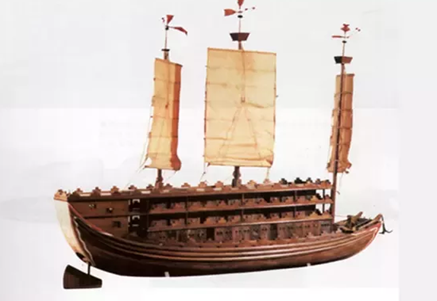
Then there were also “Spire” Class Battleships, which wereessentially oversized floating fortresses; the naval equivalent of siegetowers. They could house up to countless hundreds of men equipped with siegeengines, allowing them to easily overwhelm a fort or city’s defences once theygot up “close and personal”. That was supposing that they ever got therehowever, as their large size often meant that they were also highly impracticalto field, and an easy target to destroy via the launching of many flamingprojectiles en masse and in unison at a single concentrated area.
Their inhumanly large sizes, made for what was essentially“shooting fish in a barrel”; often the foremost priorities of enemy fireships(as self-evident below in this artist’s impression):
接着轮到“尖塔”级战舰了,这种船基本上是一种超大型的浮动堡垒;相当于海军的攻城塔。一旦它们相互联系起来,则可容纳数之不尽的满副攻城器械的士兵,足以轻松压制一座城堡或城市的防御工事。人们认为汉朝的海军已经到达此种程度了。然而由于这些战舰超大的尺寸,通常意味着对战场来说是不切实际的。而且如果对其集中的区域发射各类燃烧弹的话,它们就很容易成为靶子。
它们残暴的尺寸,从本质上来说,就是为了“在桶里捉鱼”而生的;通常会是敌方船只的优先打击目标(以下的艺术作品已经不言自明的展示了这种船只):
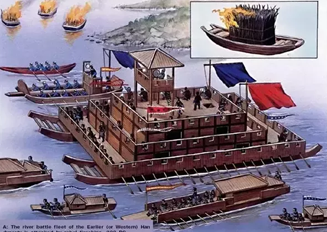
If compared to land based military units in fact, the Wing Classwas the equivalent of chariots, Stomach Strikers to battering rams, Spire Shipsto mobile assault towers and Bridge ships to the Imperial Cavalry.
Verdict: As fanciful and exotic as Chinese Naval technology may appearto some, when objectively viewed from an impartial third party point of view,it becomes fairly apparent that Roman ships were usually qualitatively betterthan their Chinese counterparts. The fact also that Rome possessed a standingNavy whilst Han China did not, deeply implies their superiority in the fieldsof Naval Technology, an expertise which they also partially acquired from thePhoenicians and Greeks. The Chinese of course, still did make some outstandingcontributions themselves in this field as well however. Rome: 4; Han: 3.
如果与陆基军事单位相比,实际上,“飞翼”级大致相当于战车,而“突胃”级则相当于攻城锤,“尖塔”级则是移动攻城塔,“仙桥”级那就是汉帝国的骑兵了。
结论:中国海军技术在一些人看来可能会显得有些怪诞和异乎寻常,从第三方的客观角度上看,罗马军舰的质量通常要比汉朝军队方面好得多。事实上,罗马拥有一支常备海军,而汉朝则没有。这也意味着他们在海军技术领域的优势,不过他们也从腓尼基人和希腊人那里获得了部分专业技术知识。当然了,中国人在这方面仍然做出了一些杰出贡献。此轮,罗马与汉朝,比分为4:3。
-----
未完待续。。。。。。
版权声明
我们致力于传递世界各地老百姓最真实、最直接、最详尽的对中国的看法
【版权与免责声明】如发现内容存在版权问题,烦请提供相关信息发邮件,
我们将及时沟通与处理。本站内容除非来源注明五毛网,否则均为网友转载,涉及言论、版权与本站无关。
本文仅代表作者观点,不代表本站立场。
本文来自网络,如有侵权及时联系本网站。
-
1
Why do most people who have a positive view of China have been to ...
- 2
- 3
- 4
- 5
- 6
- 7
- 8
- 9
- 10
-
1
Why do most people who have a positive view of China have been to ...
- 2
- 3
- 4
- 5
- 6
- 7
- 8
- 9
- 10
